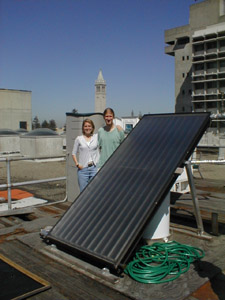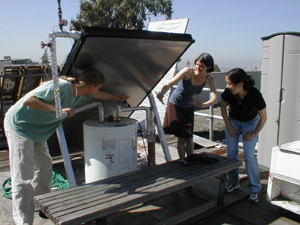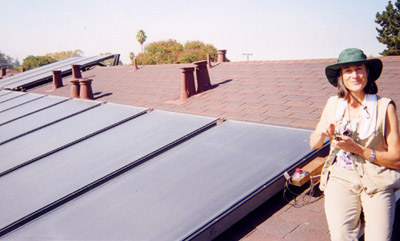
John Galloway and Jennifer Mitchell-Jackson next to a
solar hot water system at the RAEL solar test laboratory, UC Berkeley.
| RAEL Home | Mission | About RAEL | Lab Members | Projects |
| |
| Publications | RAEL News | Public Outreach | Support RAEL | Contact Us |
|
John Galloway M.S. student |
Jennifer Mitchell-Jackson M.S. student | Debbie Brockett
Undergraduate |
Jenny Edwards Research Assistant |
|
Energy and Resources Group University of California, Berkeley & | |||
|
Karina Garbesi, Ph.D. Assistant Professor | |||
|
Department of Geography and Environmental Studies California State University, Hayward | |||
Restructuring of the electricity industry is either occurring, or imminent in almost every state in the country. In the face of deregulation, most utilities have cut out energy efficiency measures. They still see their job as selling electricity, and as the market becomes more competitive, the more focused they are on this narrow mission.
Given this trend towards pushing energy consumption, and the knowledge that we face growing energy demands and real threats from climate change, policy makers need to step up to the plate and pass legislation that requires energy efficiency measures and/or renewable portfolio standards.
Under this new regulatory and market scenario, the most successful utilities will be the ones that see themselves as energy service providers, not just energy pushers. Solar hot water heater programs are one route that utilities can take towards meeting energy efficiency or renewable requirements and becoming energy service providers. The following analysis describes a particular solar hot water program that could save fossil-fuel generated energy, reduce emissions from carbon and other pollutants, promote renewables, and help utilities to retain their customers by offering them what they want.

In this project, we discuss the history of programs and policies to support solar hot water heating, along with their successes and failures. We profile current programs and policies in states that have the most active solar energy programs. Click here to view a table of current incentive programs for solar water heating. Through this process, we explore the role of utilities in promoting solar hot water systems while looking at two case studies that offer insight into this role.

Utility-scale solar hot water programs can eliminate up-front costs to consumers and secure volume discounts in purchasing. Utilities can share experiences with design and installation in a technical working group with other utilities and solar installers, and can ensure that systems are monitored and maintained. In addition to turning a profit, utilities can benefit by receiving credit toward energy efficiency or renewable portfolio goals, and by gaining customer loyalty. Solar water heating programs can offer utilities and other companies a new type of "green power" program that benefits utilities, customers, and society as a whole.
Supporting Documents:

This project monitors the system performance of two similarly configured solar domestic hot water (SDHW) systems owned and maintained by the City of Santa Clara Solar Utility. The City is concerned that these systems, installed in the early 1980s, may not be performing as designed due to a number of factors associated with system aging. We will be able to ascertain the actual energy delivered by the system, and perform a number of interesting comparisons and analyses. How do these systems compare with more "modern" systems? How do the systems compare with each other? The system designs are similar, but different water sources may be causing different levels of mineral scaling in the heat exchangers. Additionally, are these systems providing the facility owners (usually apartment complexes) with a net savings each month? Initial findings suggest a number of maintenance and infrastructure problems with the solar utility. This information feeds into the policy paper described above to illustrate lessons learned from municipal solar utilities.

Last updated 4/24/2000